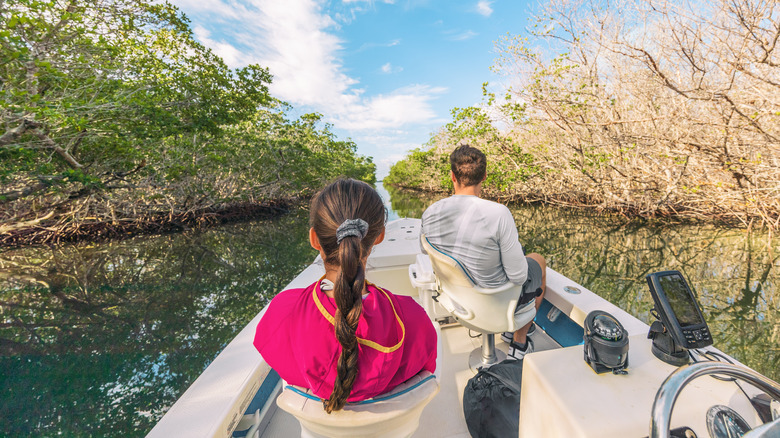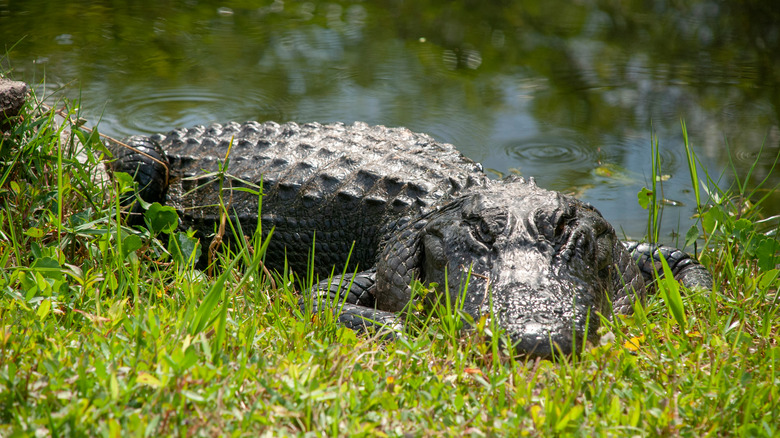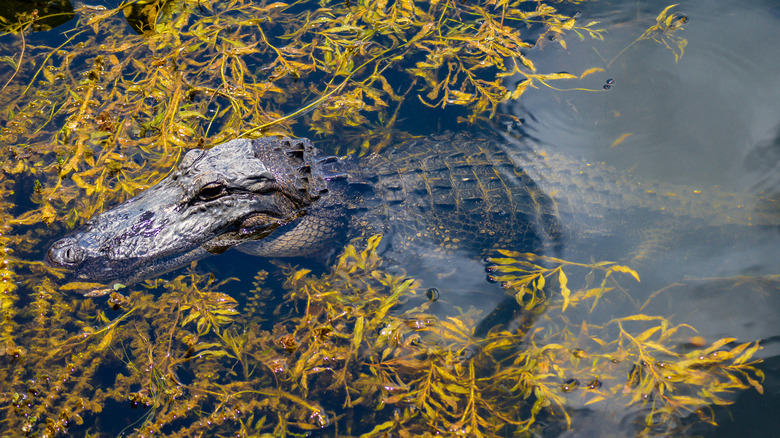The Only Place In The World To See Both Wild Alligators And Crocodiles
The thought of seeing alligators and crocodiles in real life is a terrifying prospect for some people. But for nature documentary buffs and fans of "The Crocodile Hunter," a close encounter with some of the world's largest apex predators can be a one-of-a-kind experience. South Florida is the only place in the entire world where you can see both wild American alligators and American crocodiles co-existing, making it the perfect destination for extreme wildlife enthusiasts.
Crocodiles and alligators belong to the Crocodilia order, which includes some of the largest species of reptiles on Earth. Though alligators and crocodiles may look indistinguishable upon first glance, these species have a few distinct physical features that set them apart: Alligators tend to be smaller in size and darker, while crocodiles can grow larger and have lighter skin. Moreover, crocodiles have a longer and narrow V-shaped snout, whereas alligators have a rounded and broader U-shaped snout.
Exploring alligator and crocodile territory can make for an exhilarating trip that adventurous travelers will never forget. Before venturing into the Florida wilderness, however, you should familiarize yourself with the two species, research the best spots to observe them, and learn what precautions you should take to ensure your safety.
How you can get the best view of wild alligators and crocodiles
Your best chance of getting an up-close view of these massive reptiles is by visiting Everglades National Park. Spanning across 1.5 million acres in South Florida, the Everglades is the largest subtropical wetland ecosystem in the United States. It's comprised of wet prairies, marshes, mangrove forests, cypress swamps, and other diverse environments.
American alligators mainly inhabit fresh bodies of water, including swamps and marshes. Alligators can also be found at the Big Cypress National Preserve, a 729,000-acre swamp that neighbors the Everglades. On the other hand, crocodiles can typically be spotted in "coastal, brackish, and salt-water habitats," according to the National Park Service. Other southern Florida hotspots for crocodile sightings include Key Largo and Florida Bay.
There are numerous biking paths, trails, and kayaking spots you can access to explore these areas alone. However, joining an eco-tour led by a wildlife expert is probably your best bet if you want to spot these reptiles — whether you opt for a guided walk through the wetlands or a sightseeing boat ride in the mangroves.
Overall, spotting an American crocodile is a much rarer occurrence; these animals are considered threatened, and there are estimated to be just 1,500 to 2,000 crocodiles in the Sunshine State. Conversely, around 1.3 million alligators call Florida their home. So, if you see a croc or two, consider yourself lucky!
What precautions should you take when visiting
Contrary to popular belief, American alligators and crocodiles are not the vicious killers they are often portrayed to be in films or TV shows. American crocodiles are shy and tend to be much more docile when compared to other species of crocs, which makes attacks on people highly unlikely. Similarly, American alligators are generally fearful of humans and will most likely flee if a person gets too close for comfort. Both species are protective of their eggs and hatchlings, so attentive mothers may become more aggressive if you disturb their nesting area.
That said, it's important to remember that you are entering their habitat. There are simple precautions you can take to keep yourself safe. Basic rules to follow (per the Florida Fish and Wildlife Conservation Commission) include keeping an appropriate distance if you see an alligator or crocodile, as well as swimming in the daylight and only in designated areas. Ruth Elsey, biologist manager at Louisiana's Department of Wildlife and Fisheries, told Popular Science that people should never feed these wild animals because they will "start to associate humans with food," which can increase bite incidents.
As long as you follow these rules, getting a glimpse of both the American crocodile and American alligator in their natural habitat can be a truly remarkable — and safe — experience. Visiting Everglades National Park is a must for every wildlife lover seeking a one-of-a-kind adventure. Just make sure you visit this fragile ecosystem responsibly.


